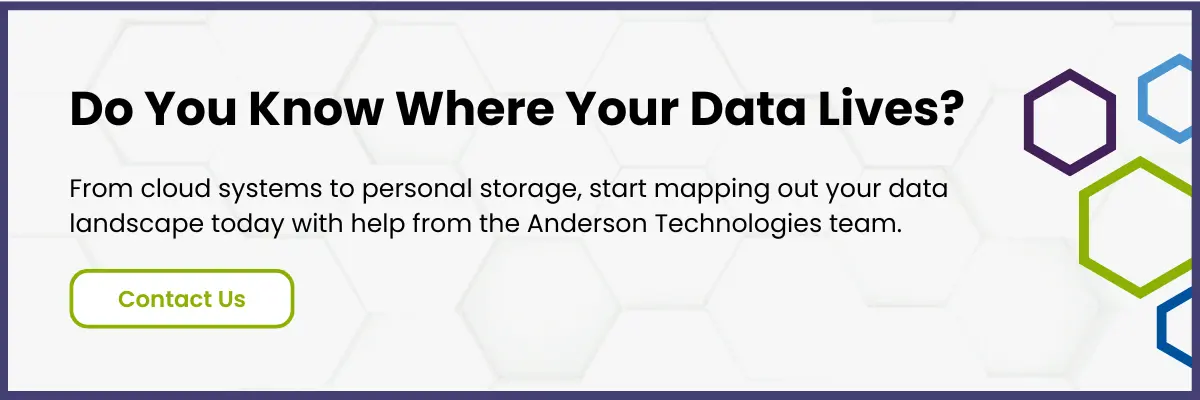Did you know that there’s an unsung hero that can make or break your merger’s success? It’s… your data! While financial projections and organizational charts often take center stage, data management for mergers tends to remain an afterthought—until it creates unexpected roadblocks in your integration, that is.
For SMBs considering a merger, understanding exactly where your data lives, how it’s structured, and who has access to it goes beyond good housekeeping. Learning about your data landscape can save you months of headaches and thousands of dollars.
Just Picture It
You’ve signed the papers, announced the merger to your teams, and everyone’s excited about the future. Then reality hits. Your inventory management system won’t communicate with the merging entity’s. Customer records exist in three different places, each with conflicting information. Half of your team can’t use critical documents because of incompatible access permissions.
These merger-threatening complications can erode expected value and damage customer relationships. Without proper data management practices, you might find yourself months behind schedule trying to untangle a web of information that should be driving your new business forward—and you wouldn’t be alone if you did.
Why Data Management Matters in Mergers
Successful outcomes from a merger depend on making the right decisions. As this Harvard Business Review podcast discusses, much of that hinges on interpreting business data effectively.
Proper data management for mergers offers three big advantages in this regard:
1. Ensures ROI on Data Projects:
First and foremost, it helps you measure actual return on investment in terms of business and customer outcomes.
2. Supports Due Diligence:
This gives you the evidence needed to communicate said value to the stakeholders involved in the merger, speeding up the process (as well as making it less painful).
3. Enables Strategic Prioritization:
When leadership understands your data landscape, they can better prioritize and plan for future data investments that will support the merged organization’s goals.
Despite its importance, data integration issues remain the number one technical reason that mergers fail to deliver projected value. In fact, 70% of processes and systems integration efforts fail in the early stages, according to Bain & Co. So what’s going wrong?
Getting to Know Your Data Landscape: Where Does Your Information Actually Live?
Before diving into what makes merger preparations effective, let’s clarify what we mean by a “data landscape.”
Think of it as the complete ecosystem where all your business information resides. It’s both the places you’re aware of and those you might have forgotten. Your company’s data landscape typically includes:
- Structured Database Systems: Your CRM, ERP, accounting software, and inventory management systems where data lives in neatly organized tables
- Document Management Systems: SharePoint, Google Drive, Dropbox, or other platforms housing your documents, presentations, and spreadsheets
- Email and Communication Platforms: Often overlooked repositories containing critical information in message bodies and attachments
- Legacy Systems: Older applications that may no longer be actively used but still contain historical data too valuable to discard
- Personal Storage: Employee laptops, local drives, and even personal cloud accounts where company information might reside without proper oversight
- Third-Party Services: Vendor platforms, SaaS solutions, and external services where your data extends beyond your direct control
- Physical Records: Paper documents, external drives, and backup media that still exist in many businesses despite digital transformation efforts
The complexity of this landscape is precisely why using IT services for data management assistance is advisable during mergers. Without professional guidance, it’s almost impossible to identify all the places where critical business information lives, and that leaves you vulnerable to data loss, security breaches, or compliance failures during integration.
When Combining Data Landscapes, Compounds Pre-Existing Problems
In a merger, there’s a high chance you’ll have to undergo data migration. Whether this is between internal departments or different external companies, data from every party will need to be consolidated and—ideally—transformed into a useable resource for everybody.
This is where this issue lies. The way your team gathers, uses, and measures data is likely to differ from the way the team next door does it. Without proper IT data management, these incompatibilities amplify existing problems, making the newly merged landscape a complete mess—and a nightmare to work with.
This could mean:
- Security Vulnerabilities Increase: Different security standards across organizations can create dangerous gaps when systems are connected without proper planning.
- Data Quality Issues Multiply: Merging clean data with problematic data doesn’t average out—it creates entirely new problems at scale.
- Compliance Risks Emerge: Regulatory requirements that were previously met by separate entities may be violated when data systems are merged without adequate oversight.
- Integration Costs Skyrocket: What should be straightforward connections between systems often require expensive custom development when data structures aren’t compatible.
Getting ahead of things before these problems compound can significantly reduce both integration timelines and costs—and that all starts with a clear picture of your data landscape.
Your First Critical Step: The Pre-Merger Data Audit
Before you can effectively merge data systems, you need to know exactly what you’re working with. A comprehensive data audit conducted by professionals specializing in IT data management consulting can identify:
1. All Data Storage Locations:
Cloud-based systems, departmental solutions, on-premises servers and databases, personal storage used for business purposes, and legacy systems that may contain historical data.
2. Data Access and Security Protocols:
Who currently has access to what information, authentication methods and their security levels, regulatory compliance status for sensitive data, and third-party access points that might create vulnerabilities.
3. Data Quality and Redundancy Issues:
Outdated or inaccurate records, duplicate information across systems, inconsistent formatting that will complicate integration.
Manual mapping takes time, so enlist the help of an experienced provider. By using IT services to conduct this audit, you gain visibility into potential problems long before they derail your timeline—as well as the steps to rectify them.
Using IT Services for Data Management: Five Steps for Landscaping Success
With a clear picture of your data landscape, it’s time to develop a strategic integration plan. Most successful mergers approach data integration in phases rather than attempting a “big bang” approach.
1. Cleaning Up Redundant Info:
Duplicate and outdated data accumulates over time, especially when businesses grow through acquisitions. Identifying overlaps and consolidating redundant records not only streamlines operations but also reduces unnecessary storage and maintenance costs.
2. Consolidating Chaotic Sources:
Data scattered across multiple platforms and outdated systems can make it difficult for both buyers and internal teams to assess business performance. Modernizing and consolidating your data sources into a unified system enhances visibility, ensuring decision-makers have accurate and actionable insights—which makes your business more attractive for investment and long-term success.
3. Common Data Definitions and Standards:
Before technical integration, both organizations need to agree on what data means. Is a “lead” the same thing in both companies? Does “active customer” have the same definition? These semantic differences often cause more problems than technical incompatibilities.
4. Securing Access…:
The acquiring company won’t want to inherit compliance issues, making it essential to review, update, and enforce your security policies before integration. Ensure both organizations have strong security protocols in place and that all stakeholders understand how sensitive data is handled.
5. …& Accessibility:
While security is critical, it shouldn’t come at the expense of usability—teams still need fast, reliable access to essential data. Standardizing how data is stored, accessed, and shared ensures consistency across departments, particularly as new employees and stakeholders join the organization.
Even if a merger isn’t imminent, proper data management goes a long way to improve operational efficiency and security. Whether or not you’ve got an acquisition on the horizon, it’s well worth reaching out to an experienced team for help mapping out (and leveling up) your data landscape.
Anderson Technologies: Real People Creating Business-Changing IT Solutions
For over 30 years, Anderson Technologies has guided businesses through successful mergers with our specialized IT data management consulting services. Our team understands both the technical and human challenges of data integration during business transitions.
We approach data management for mergers as a strategic advantage rather than just a technical necessity. By mapping your data landscape, developing customized integration plans, and providing ongoing support, we help ensure your merger delivers its expected value—and often more.
Ready to make your upcoming merger a data success story? Contact us today to get started.



